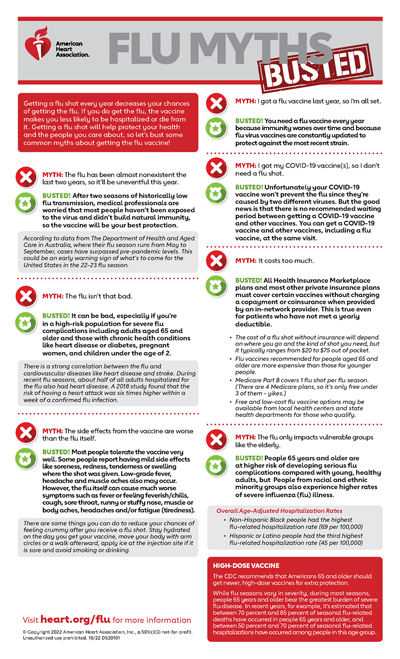Flu Myths Busted!
FALSE: The flu will be no big deal this year, just like the last two years.
The truth: After two seasons of historically low flu transmission, medical professionals are worried that most people haven’t been exposed to the virus and didn't build natural immunity.
According to data(link opens in new window)(link opens in new window)(link opens in new window) from The Department of Health and Aged Care in Australia (their flu season runs May to September) cases have surpassed pre-pandemic levels. This could be an early warning sign of what’s to come for the United States.
FALSE: The flu isn’t that bad.
The truth: It can be bad, especially if you’re in a high-risk population for severe flu complications including adults 65 and older and those with chronic health conditions like heart disease or diabetes, pregnant women and children under the age of 2.
There’s a strong correlation between the flu and heart disease and stroke. During recent flu seasons, about half of all adults hospitalized for the flu also had heart disease. And a 2018 study found that the risk of having a heart attack was six times higher within a week of a confirmed flu infection.
FALSE: The vaccine’s side effects are worse than the flu.
The truth: Most people tolerate the vaccine very well. Some people report mild side effects like soreness, redness, tenderness or swelling, low-grade fever, headache and muscle aches.
But the flu can cause much worse symptoms such as fever or feeling feverish/chills, cough, sore throat, runny or stuffy nose, muscle or body aches, headaches and/or fatigue.
Reduce your chances of feeling bad after you receive a flu shot. Stay hydrated, move your body with arm circles or a walk, apply ice at the injection site if it’s sore and avoid smoking or drinking.
FALSE: I got a flu vaccine last year, so I’m good to go.
The truth: You need a flu vaccine every year because immunity wanes over time and because flu virus vaccines are constantly updated to protect against the most recent strain.
FALSE: I got my COVID-19 vaccine(s), so I don’t need a flu shot.
The truth: Unfortunately your COVID-19 vaccine won’t prevent the flu since they’re caused by two different viruses. But the good news is that you can get a COVID-19 vaccine and other vaccines, including a flu vaccine, at the same visit.
FALSE: It costs too much.
The truth: Even if you haven’t met your yearly deductible, Health Insurance Marketplace plans and most other private insurance plans must cover certain vaccines without charging a copayment or coinsurance when provided by an in-network provider. Free and low-cost flu vaccines may be available from local health centers and state health departments for those who qualify.
FALSE: Only elderly people need to worry about the flu.
The truth: People 65 and older are at higher risk of developing serious flu complications(link opens in new window)(link opens in new window)(link opens in new window) compared with young, healthy adults, but people from under-represented racial and ethnic groups are also hit harder by the flu.
Overall age-adjusted hospitalization rates:
- Non-Hispanic Black people had the highest flu-related hospitalization rate (69 per 100,000)
- Hispanic or Latino people had the third highest flu-related hospitalization rate (45 per 100,000)
View or Download Fact Sheet
English (PDF) | Spanish (PDF)
